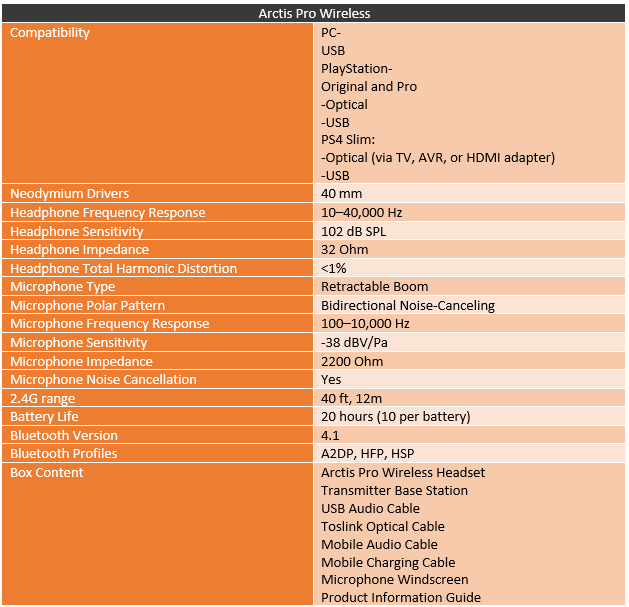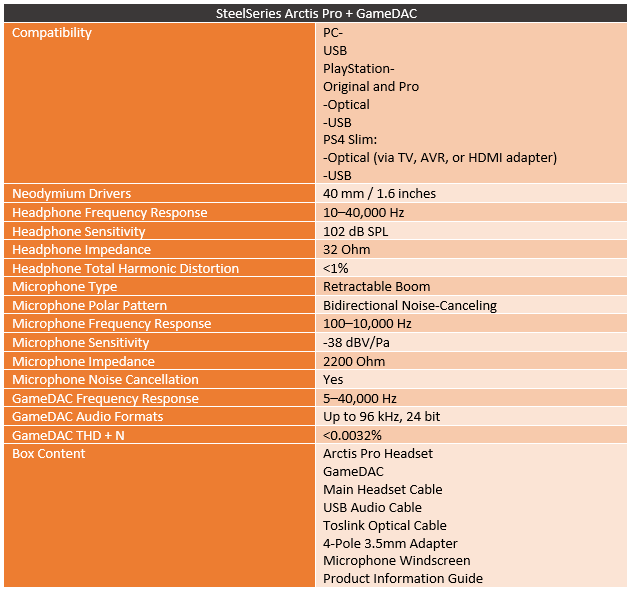All the way back in November 2016 I took a look at the SteelSeries Arctis 5 and was impressed with the direction they were going. It even earned out top honors and an editors choice award. But I was waiting on the change to check out the Arctis 7 because I hate getting tangled in the wires. Well later in mid-2017 I covered the Arctis 7 and while I was really happy with it I felt like it had lost a few features from the H Wireless that were great. Well, we are back at it again, only this time SteelSeries has brought out two headsets for the high end of their product line with the Arctis Pro name. One is the Arctis Pro Wireless, I can’t wait to see how that compares to the Arctis 7 that I have been using for the past year. The others are wired Arctis Pro’s, they are the same headset only one also comes with what they call the GameDAC, a desktop DAC for those who don’t have a high-end audio card or DAC already. Today I will be checking out that version alongside of the wireless to see if both are worth their wallet busting price points.
Product Name: SteelSeries Arctis Pro + GameDAC and Arctis Pro Wireless
Review Samples Provided by: SteelSeries
Written by: Wes Compton
Pictures by: Wes Compton
Amazon Affiliate Links: SteelSeries Arctis Pro + GameDAC and Arctis Pro Wireless
Specifications
SteelSeries Arctis Pro + GameDAC
So I’m going to check out the Arctis Pro +GameDAC first. It comes in a white box with a picture of both the headset and the GameDAC across the front. The SteelSeries branding isn’t too in your face up in the corner. They mention that this is the worlds first certified hi-res gaming audio system and have PS4 and PC listed down with the Dolby logos to show what devices that it works with. The back of the box has another set of pictures of the Arctis Pro with the GameDAC, both on again showing off the lighting and the OELD screen on the GameDAC. Below that they have four features highlighted with information below in three different languages.


The box pulls apart and the headset and GameDAC are front and center in between the formed plastic on the top and bottom to keep them from moving around at all. There is also a box filled with accessories up under the plastic. This has the documentation, a product information guide, and a warranty information card.


For accessories you get a few different cables, each is labeled with a white sticker tag. You get an optical cable, a USB cable, a mobile adapter, and the main cable that runs between the GameDAC and the headset. There is also a microphone windscreen in the plastic bag that you can put over the microphone if you need one.


So the Arctis Pro can be found on its own but this time around it comes with the GameDAC. A DAC is a digital audio converter and you might be wondering why they don’t call it a sound card. Well technically a sound card has a DAC as well, the DAC converts a digital signal to the analog signal that you hear. This one specifically is running an ESS Sabre 9018 reference DAC with 121 dB of dynamic range and -115 dB THD+N. the GameDAC also has an amp built in as well. In other words, a DAC and the GameDAC is just an external Sound Card but the DAC name has recently been associated with higher quality audio and that is what SteelSeries is going for here.
So the GameDAC is about 4 inches wide and oval in shape. The top is extremely glossy and has two controls on top. One is a rubber knob, similar to a volume control, but it has more functionality than that. It helps you navigate the OLED screen that takes up most of the top. The knob can be pressed in for a click and then there is a second button to the left giving you a backup and forward/confirm controls.



Around back is where you will find most of the connections. So the optical connection can let you hook into a preexisting audio card or into the optical out on your PS4 or other home theater device. The USB connection, when paired with the included cable, is how you hook up to your PC or PS4 as well. There is a line out that you can run from the GameDAC to your streaming mixer to give you control over what everyone hears. Then the mobile in connection uses a 3.5mm headphone jack cable to bring in audio from your phone assuming you have a headphone jack anymore or you can hook it right to your Xbox controller as well or even the Switch. The odd-looking connection on the left side of the GameDAC is for the cable that runs to the headset, this is a proprietary cable. You could use the GameDAC without the headset using the line out jack on the back for a speaker out.


The bottom of the GameDAC has a thick rubber foot that goes all the way around the outside edge to help keep it from moving around. This is important because of the controls on top. Beyond that, this is where all of the FCC and CE certification logos are along with the product name, model, and serial number.

For some size perspective here is a shot of the Arctic Pro headset with the GameDAC.

On initial glance, the Arctis Pro looks just like the original wired versions. Especially with the unique shape of the earcups that they went with. They have an oval shape with straight sides that are better at going around most ears than a round design without having to be as large. The earcups are mounted on the headband with an arm that changes the pivot point to about 45 degrees to the right so they can rotate but side to side and up and down slightly on the same axis. That design is similar to the Arctis 5 as well only now that arm is grey, not black.


It’s the headband when we first see real changes. The headband design is a lot more like the wireless Arctis 7 than the wired Arctis 5. That is because the elastic strap goes up around the top on the Arctis Pro. The headband is aluminum like the Arctis 7 but this time it is black not the silver. So you have the extra long strap that had more adjustment and also adds a little style to the headband. SteelSeries does have a few options for the headband replacement available for the Arctis Pro lineup but still none of the really cool Design by Humans designs they teased a few years ago. The elastic headband allows for some adjustment and it itself is a lot more flexible than a normal headband design so even without adjustment it should fit most people.


So only one earcup really has anything going on as far as controls or connections. That is the left earcup. This is where the microphone is located, then moving around to the bottom of the headset you have a recessed connection. The recessed connection is for the proprietary cable that goes between the headset and the GameDAC. Well technically it is a USB B Mini connection, but no one uses that so you will have to rely on SteelSeries if you need to replace that cable in the future. It's awesome that it is replaceable, but a more standard cable would have been nice. Paired up with that is also a 3.5mm jack that you can use as an input or output. I spent a bunch of time trying to confirm this and didn’t see anything about this jack mentioned on the SteelSeries website or any of the video or written reviews. So I dug out a 3.5mm to 3.5mm male to male cable. I tested the input first by hooking the headset up to my phone and played audio to the headset while the GameDAC cable was also hooked up. Then I unhooked my phone and hooked another headset up and played music through the GameDAC. It played through the Arctis Pro and also shared the signal with the second headset.

Also on the left earcup, there is a volume control and then a microphone mute button. The mute button is large and easy to get at. The volume control has a great grip on it but it is important to note that this runs independently of the volume control on the GameDAC. They did this because when you have it hooked directly up to a game console or mobile device you still need some volume control, but if you have it turned down here you will wonder why the headset is so quiet. I will talk more about that in the performance testing though.

So the outside of the earcups now have removable plates. This design should make it easy to do some customization on your own or to buy customized plates from SteelSeries. In fact, they already sell them along with matching headbands. I personally might just pull them off and paint them. They attach with magnets and then around the outside edge there is RGB lighting.

The inside of the earcups is where the magic happens so to speak. So for starters, you can better see how the oval design can help fit around ears. They paired that up with ultra thick memory foam in the padding with a microfiber cloth. SteelSeries calls the fabric their airweave fabric and they do sell replacements on their website. I was disappointed to not see the other earcup options available though like they have with the original Arctis lineup, I still to this day want the velour version. As for the drivers inside of the earcups, I was curious how they compared to the Arctis 5 so I pulled up the specifications. They are both 40mm drivers so that didn’t change but the new frequency response is much better going from 20-22000 Hz on the 5 to 10-40000 Hz now, so there is a little more range on the low end and the high end has doubled! Sensitivity went from 98 dB up to 102 dB and distortion is down from <3% to <1%.

The microphone design is the same as previously with the pull-out design that you can hide away when not using it. The head has the same openings and the red LED light strip along the top edge to help you see when you are muted. The microphone specifications are about the same as before with a frequency response of 1000-10000 Hz but sensitivity has improved from -48 dB to -38 dB.

Arctis Pro Wireless
So in a lot of ways, the Arctic Pro Wireless is like the Arctis Pro that we just went over so I am going to try to be a little shorter here to focus on what is different about it. One thing that is a lot alike was the packaging. While this box was a little bigger it does have the same white background and a large photo of the headset on the front. Only this time there is a different controller, not the GameDAC. The picture on the back shows the headset and receiver again only this time it also includes the two batteries in the picture. Then they run through the features again in all three languages.


The Arctis Pro Wireless comes nicely in tight in between the two formed plastic shells with the receiver/base up under the headband. Then under all of that, you will find a box with all of the accessories. The information guide and warranty card are just about the same with the exception of the name on the cover and all of the wireless setup information.



As for the rest of the accessories, things are a lot different for this one. We have more cables for starters. You have a USB cable for the transmitter that goes to your PC or PS4. There is a mobile audio cable that plugs directly into the headset. The mobile charging cable is something you won’t need most of the time. The base charges the batteries but this is nice to have to plug the headset directly in when traveling or when you need to update the firmware. That cable is USB to a USB B Mini connection, the same weird one that the Arctis Pro uses as well. There is a power cable for the transmitter base, this is USB to a round charging plug. Then like the Arctis Pro you get an optical cable for those more direct connections. Also, included is another microphone windscreen and the batteries. One comes installed and the other on its own to be put in the charger.


So one of the big differences between the Arctis Pro and the Arctis Pro Wireless (beyond the whole wireless thing) is the base that is included. Well, SteelSeries calls it a transmitter but to me, this is the hub and charging base where you charge the included swappable batteries. This is extremely different than the GameDAC included with the other combo but oddly enough this unit isn’t really new at all. It was originally designed for the H-Wireless and transitioned to the Siberia 800 when they rebranded to that. I recognize it because I used the H-Wireless for a long time. Now the wheel has changed to match the one on the GameDAC and the base is different but overall this is the same look. The front has a wheel that you can flip through settings on and press in to confirm and then a back button just like the GameDAC. There is also an OLED display on the front although this one is smaller than the GameDAC and it doesn’t have as many features. It does let you flip between all of the different connection options though.


Speaking of the connection options, the back of the transmitter helps show what you can do. You have line in and outs both with 3.5mm jacks and optical connections. Then there is the USB plug for the PC and PSU and an optional DC power connection. I learned later in my use of the H-Wireless than this was optional when hooked up via the PC USB connection, but you will need it if you use audio from the optical or line in connections.

What stands out about this base compared to just about any other headset (beyond the H-Wireless) is the battery charger on the right side. This is really what I was missing with the Arctis 7 and I talked about it a few times in that review. But you keep a battery in this charged and ready to go for when the battery in the headset runs out, so you never have to plug it in.

I mentioned the base having a different design. There seems to be a little more rubber overall. Beyond that, the normal certifications are all there as well as the model and serial number information you would need if you have a problem in the future.

I snapped a few shots of the transmitter with the headset itself, you can see that it is a little larger than the GameDAC. The GameDAC is a little wider but about half as deep and thinner as well.



So the earcup design has that same squared off oval design that all of the Arctis headsets have had and nothing changed here on the Arctis Pro Wireless. In fact, nothing here looks any different than the Arctis Pro I just talked about in the last section. The mounting design is the same with the 45-degree mounting point on an arm that also spins to allow you to lay the earcups down flat.


Now when it comes to the connections and buttons the left earcup is the main hub, just like with the Arctis Pro. In fact, there is only one thing changed from the Pro to the Pro Wireless on that earcup. This one has added a micro-USB charging port. You still have the volume control and the large microphone mute button. The USB B mini connection is there, so at any point in time you can hook the Arctis Pro Wireless up as a wired device. There is also the 3.5mm headphone jack as well that you can use as an input to listen to something from your phone or you can use it as an output to share what you are listening to with someone else. They just have to plug their headphones into it. Now the Pro Wireless does have a few things over on the right earcup (left in the picture) where the Arctis Pro didn’t have anything. This is where you can find the power button to turn the headset on. You can also put the headset into Bluetooth pairing mode with the Bluetooth button. This will let you sync any Bluetooth capable device to it, so if you are working with your headphones on you could sync your phone and take calls when needed as well.

The microphone is unchanged, so you get the same pullout hidable microphone that SteelSeries has always been known for. Only with the Arctis line, the microphone quality has been drastically improved. From what I can tell things have improved on the connection quality as well, in the past, they had issues with microphones dying from being pulled in and out but I haven’t heard of that being a big issue on the Arctis headsets. Specifications show the microphone unchanged from the Arctis Pro so that means the same 100-10000 Hz frequency range and -38 dB sensitivity.


So the headband design is a suspension design meaning there is an inner and outer headband. The outer band is the solid band, in this case, it is made from aluminum and finished in black. The other band wraps around the top but is loose on the inside so that it holds the headset up, keeping the aluminum band away from your head. In the past, before the Arctis line, SteelSeries did this with leather straps and a spring design, but they simplified things going with just elastic. The Arctis Pro Wireless and the Arctis Pro have the same design here, sharing the same design with the Arctis 7 as well that also went up and over the top band. You can get replacement bands in different designs as well as replacement magnetic earcup covers that match as well.



So I mentioned the removable earcup covers just a minute ago. Here is a better look at them. There is a small tab at the bottom where you can get a nail up under them and then they are held in place with magnets. This design was on the Arctis Pro but it is clear the whole reason for it is the Wireless model here. That is because they have the swappable battery up under the earcup, just like with the H-Wireless. This design is a lot easier to work with though, the H Wireless required that you twist the cover to get it off then you had to line it back up. All while still being in game. Now it goes on and off without looking. The whole swappable battery is unique and everyone should do this. I personally hate having to plug my wireless devices in and I always forget to do it. This design means you never plug in and you just swap between the two batteries when you need it. There is always one 100% charged so you never run out of juice.




As for what is inside of those earcups. Well, the Arctis Pro Wireless has the same 40mm drivers than the Arctis Pro’s have. That means the same 10-40000 Hz frequency range as well, putting them up well beyond what most gaming headsets are capable of. Now that is only if the wireless tech can get that good of quality to the headset and they don’t show much information on that. Just that it has a 40-foot range. Worse case the headset is capable of that range when plugged in via the wired connection.

I did grab the Arctis 7 that I have been using for the past year now to see if there were any big changes in the headset design. You can see how the silver headband makes a big difference in the looks. Beyond that, you can see the custom headband that my Arctis 7 has. Beyond that, on the earcups, the branding is now a little more subtle. On the underside with all of the hookups and buttons. We can see that the chat mix control is no longer built into the headset. There is also the addition of the Bluetooth connect button and the two status LEDs between those buttons.


Audio Quality and Performance
So for a month or two now I have been running the Arctis Pro Wireless as my main headset and I have slipped in some testing of the Arctis Pro +GameDAC in with that as well. So we can finally sit down and talk a little about how they both compare to past Arctis products as well as some of the competition. That testing included movies and music that I listen to when working and of course gaming when I can as well. Basically, everything all of you will be doing. Before getting into the audio performance and comfort I did want to touch on the setup and experience with each headset.
Starting with the Arctis Pro once I pulled everything out of the box I hooked the GameDAC up to my PC using USB and plugged the headset into the GameDAC using the included cord. The cord itself is designed to only fit one way and the recessed area on the headset is shaped to prevent you from using other cables. Once hooked up the GameDAC was picked up right away without any software being downloaded and it prompted me on its screen through a few things. Basically, they show you how to use the dial to flip through settings and with that they also run through a few different things you can set up. Basically, all of the instructions are on the screen, when finished they tell you to GLHF as well.



Once powered up the lighting on the Arctis Pro lights up around the earcups. You can also see the microphone mute LED here as well.
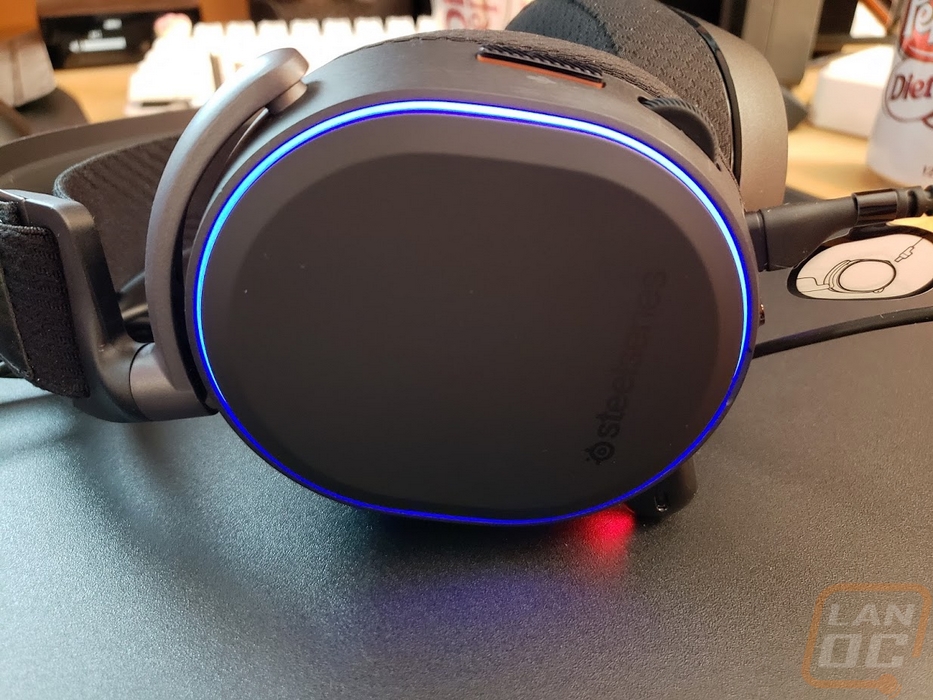
Once up and rolling the main screen you will see when using this with a PC has two main circles on it. The one on the left is the volume and on the right is the chat mix, this is where you can adjust more or less game volume in relation to your voice coms to help you hear someone when gaming. The screen also always lets you know if DTS is turned on or off, what input you are using right now in the top left corner, and then the current audio connection rate.
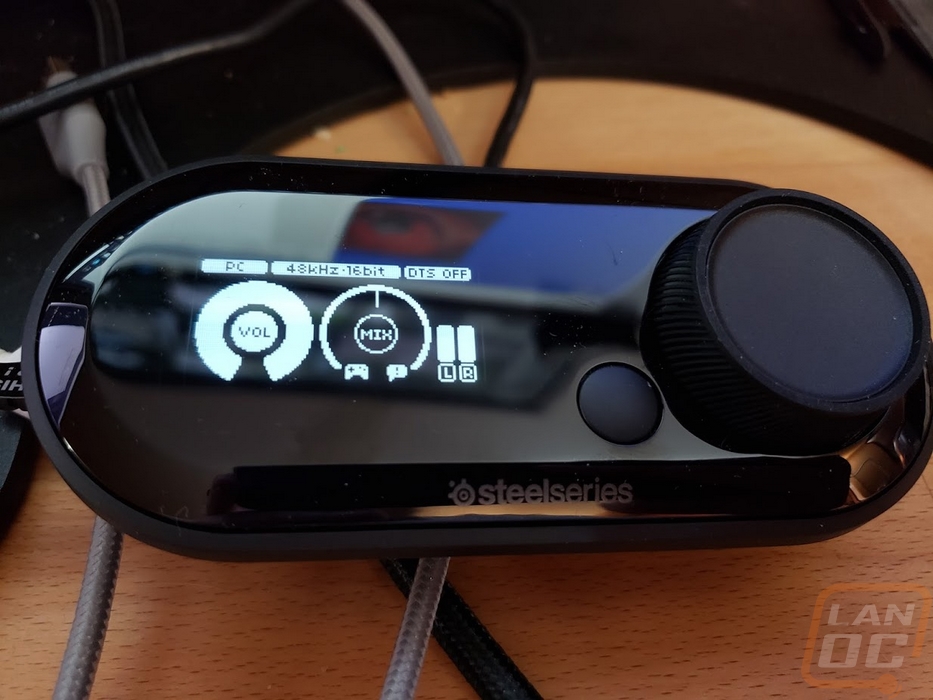 Switching over to the Arctis Pro Wireless, getting things set up was a little more complicated but not by too much. You have to get the transmitter or base installed. For PC use you can get away with just the one USB cable, but I made sure to hook up both that and the optional power so I can use the headset even when the PC isn’t turned on. The headset comes synced by default so there isn’t anything to do there. You just need to power it on and make sure the battery is charged. You can see the status of the battery in the top left corner and on the right that is the status of the battery you have charging in the base.
Switching over to the Arctis Pro Wireless, getting things set up was a little more complicated but not by too much. You have to get the transmitter or base installed. For PC use you can get away with just the one USB cable, but I made sure to hook up both that and the optional power so I can use the headset even when the PC isn’t turned on. The headset comes synced by default so there isn’t anything to do there. You just need to power it on and make sure the battery is charged. You can see the status of the battery in the top left corner and on the right that is the status of the battery you have charging in the base.
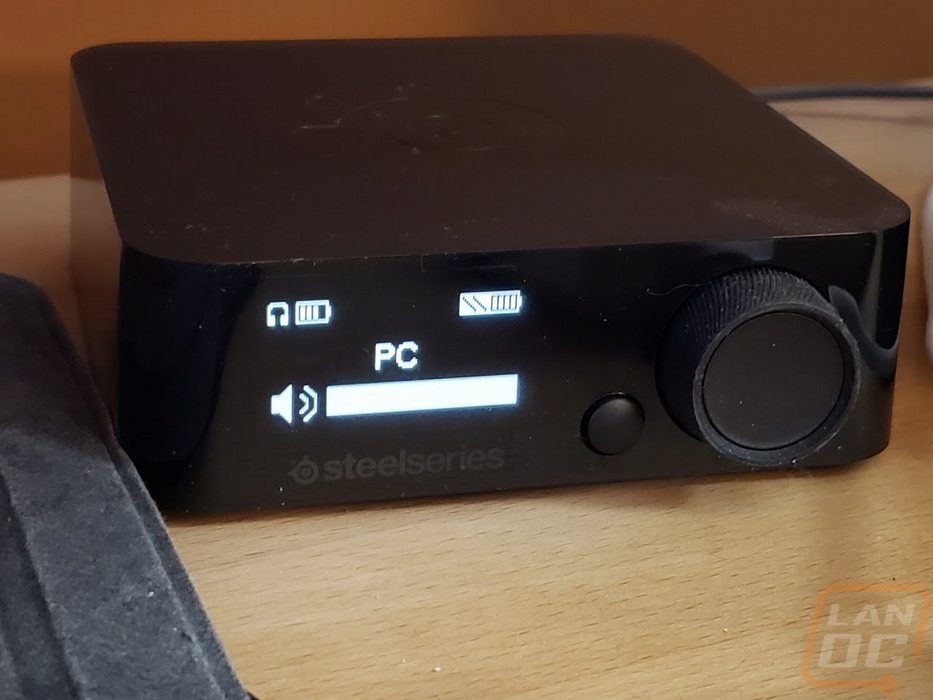
Once all hooked up the base guides you through a quick setup to pick your input device. Once setup it will show the input device on the main screen all of the time with a bar volume display. You can see I have it turned all the way up here. You can tell if you have the headset powered on because of the headset icon and battery status in the top left corner. You will notice in one of the pictures below the headset was off and nothing shows up in that area.
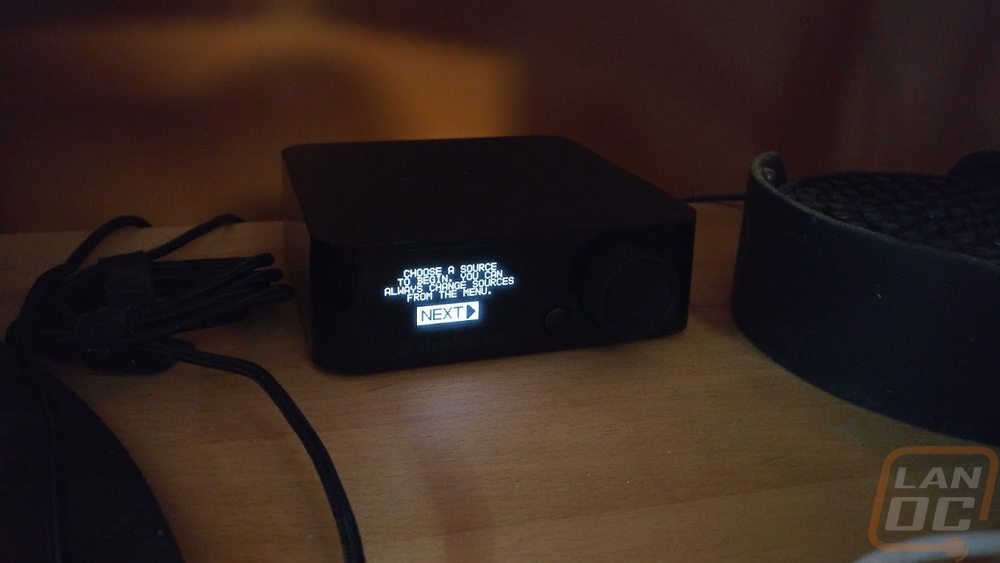
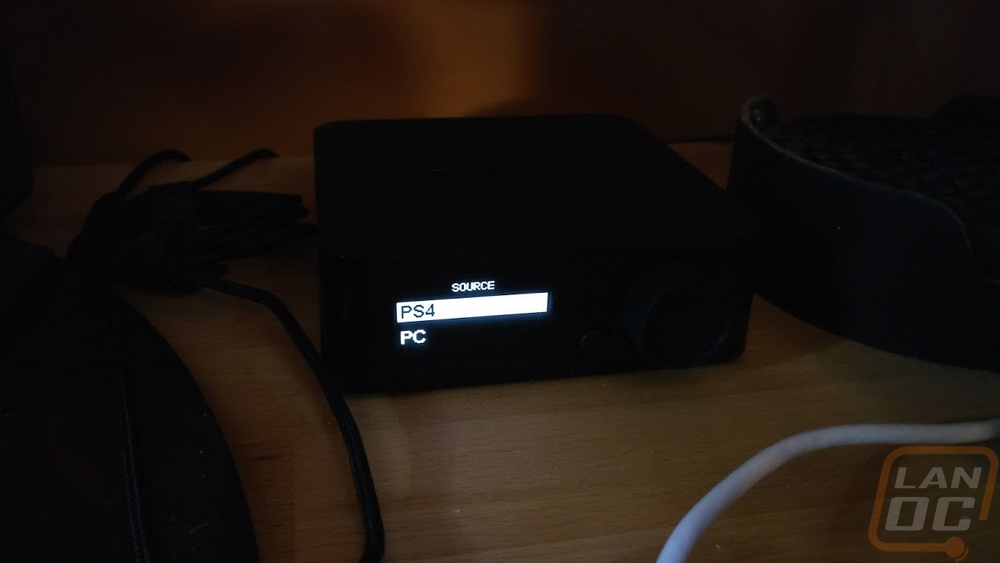
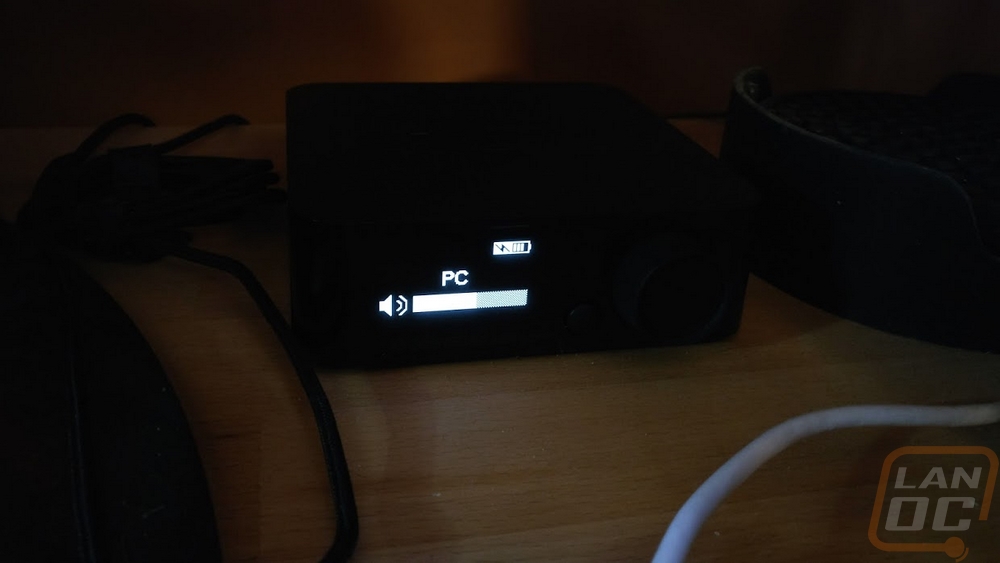
Next, I did download and install the SteelSeries Engine 3 from the SteelSeries website. Honestly, both headsets can function completely without the software but I did want to check for updates and as you can see from the first page all three headsets (Arctis 7 included) needed firmware updates. The software itself hasn’t changed too much in the past few years. You have the main page where you can see all of your plugged in SteelSeries devices. Then when you open one it will open up another window. I still don’t like that too much, I would prefer it all stay in the one window. But once open the software for the Arctis Pro + GameDAC gets us mostly the same options that are available in the DAC itself. You can turn DTS on or off, create your own EQ profiles or pick from a few basic profiles.


The lighting tab, on the other hand, did have some options. You can program the lighting for each earcup independently or together and the microphone LED as well.


The Arctis Pro Wireless doesn’t have too many options as well but the EQ options here aren’t available on the controller. You will notice however that there are fewer EQ bars available than on the GameDAC. I was happy to see that they have added options on when the headset will turn off and how Bluetooth functionality works. This includes the option o mute game audio when you get a call. There is also a set of options for the OLED screen brightness and its screen saver. This is huge because with my H Wireless the screen did get really bad burn in over a few years of use.

 With all of the software and setup details setup, I could finally dive into some of the overall performance aspects. I wanted to talk about the comfort first because no matter how good a headset sounds I know I will personally never use them if they aren’t comfortable. Honestly, as long as SteelSeries didn’t mess anything up from the Arctis 5 and 7 I was going to be happy because those are still some of the most comfortable headsets I have. And yes, both the wired and wireless Arctis Pro models were still comfortable. The overall shape hasn’t changed and earcup padding is still memory foam with the same microfiber material. So they both fit around my ears well, fit my large head, and didn’t cause any noticeable issues. Now being a sealed earcup design they do still get a little warm like before, so I did spend a lot of time pulling an earcup off to cool down when heavy into gaming. I noticed also that when I first put them both on the headband was a little tight, but once it broke in its comfort actually improved.
With all of the software and setup details setup, I could finally dive into some of the overall performance aspects. I wanted to talk about the comfort first because no matter how good a headset sounds I know I will personally never use them if they aren’t comfortable. Honestly, as long as SteelSeries didn’t mess anything up from the Arctis 5 and 7 I was going to be happy because those are still some of the most comfortable headsets I have. And yes, both the wired and wireless Arctis Pro models were still comfortable. The overall shape hasn’t changed and earcup padding is still memory foam with the same microfiber material. So they both fit around my ears well, fit my large head, and didn’t cause any noticeable issues. Now being a sealed earcup design they do still get a little warm like before, so I did spend a lot of time pulling an earcup off to cool down when heavy into gaming. I noticed also that when I first put them both on the headband was a little tight, but once it broke in its comfort actually improved.
So with comfort, I could talk about both at the same time, but for audio, I wanted to split my experience up for each headset because they can and will be different when it comes to having the GameDAC or wireless. Starting with the Arctis Pro + GameDAC I have to say that the audio quality was noticeably different, even coming from the original Arctis lineup. That alone said a lot to me, because the original 5 and 7 are both great headsets. I have spent a lot of time with high-end headsets from companies well beyond just gaming companies so my expectations were high with this headset. But I can say that SteelSeries impressed me. With the GameDAC and Arctis Pro paired up the audio was crisp and clear and WELL above what other gaming headset options have offered. Pairing them up together is also huge because a lot of people will spend a lot on a headset only to hook it up to onboard audio or worse.
That said I did notice that when I first tried out the Arctis Pro +GameDAC the volume was lower than I would have hoped. After some messing around I found that the volume control on the headset was turned down a little. So as a reminder, remember that the volume control on the GameDAC and on the headset itself are independent. Even with that turned up I wanted a little more, I had to dig into the settings and turn the gain up to the high setting. There are some EU rules that don’t let the headset be cranked up out of the box to protect hearing. Even beyond the audio performance, I was a big fan of the GameDACs screen showing the left-right EQ all of the time. Volume was easier to see and having the chat mix level visible should help some people who don’t realize they have it not in the center when they have audio issues.
As for the Arctis Pro Wireless, I spent even more time with this one because at my main desk I prefer to be wireless for my audio. It allows me to get up and get something to drink or even go to the bathroom without missing out on voice communication from the people I’m playing with. That said typically wireless audio performance is a step below a good wired setup. Going from the Arctis 7 that I use every day to the Arctis Pro Wireless there was a noticeable improvement in audio performance. With double the frequency range that wasn’t a big surprise. That said when wiring the same headset up to my DAC the performance did improve. I don’t think you are going to find a better sounding wireless solution though.
The big thing for me was getting the hot-swappable batteries back. That was honestly the biggest issue I had with the Arctis 7 and even after using it for a year I would still forget to plug it in until it died in the middle of a game over and over. That isn’t an issue with the Arctis Pro Wireless, battery life is between 9 and 10 hours for each battery so unless you are using them 24/7 you won’t have to swap it out each day, but when they do die in the middle of your game you just grab the already charged battery and you are good for another 9/10 hours. I was a little disappointed to see the same transmitter base as the H-Wireless. I would honestly be fine with a much smaller option that just could charge the battery. But the extra connection options could be nice if you have a game console at your desk. I don’t myself, not anymore at least, so the extra money spent having the screen and input switching would be better spent somewhere else. Wireless range was great, I could get to almost anywhere on the main level of my house without it disconnecting so sneaking off to do something wouldn’t mean a missed queue or anything like that.
Overall and Final Verdict
Normally you can kind of see a product coming simply because there is a big hole in the market. But These headsets came as a surprise to me when they were announced. That isn’t to say there wasn’t a big gap in their product line at the high end, but frankly, all of the gaming headset companies have had the same hole for years and no one has really wanted to jump into it. People who want higher quality audio in a gaming headset have been left to pick up options from traditional headphone companies and add their own microphone or more recently a few of those companies have finally started to make a push into the making market. I think that is the reason you see SteelSeries making this jump, people have been spending the money buy expensive headphones and expensive microphones to go with them. Not to mention headphone DACs and amps to go with them.

Now the Arctis Pro + GameDAC and the Arctis Pro Wireless have a bit of a different market focus. The Pro with GameDAC is perfect for people who want an all in one solution that will guarantee them great audio quality. This is a good portion of the market, not everyone has the time to find a DAC that will work for them, then find the best value in a pair of headphones then add a microphone. Don’t get me wrong, if you do that I guarantee you will be able to put together something cheaper with great performance. But the Arctis Pro + GameDAC is that out of the box for everyone else. The Arctis Pro Wireless, on the other hand, might be made specifically for someone like me. Someone who hates plugging their wireless device in to charge, who wants good audio quality while understanding that wired will still be better, and someone who wants something comfortable. The H-Wireless back in the day had years of use from me while not being all that comfortable or having great audio performance. I put up with all of that just to have that easy battery hot swap. After all those years I moved to the Arctis 7 because it did have good audio quality and was very comfortable. But I lost the battery swapping. Well, I can finally have both and they have added Bluetooth to get my phone calls while in game as well.

Both options have customization options available from SteelSeries in the way of headbands and the new magnetic earcups that match. Like before I was a little disappointed to not see single color options that people could get to match their setup. The color wave look they have is kind of cool, but I know a lot of people just want their red or orange or green etc. They also dropped the other earcup padding options like the velour that I wanted to upgrade my Arctis 7 too. The Arctis Pro Wireless has the same old screen setup that goes back to the H Wireless, I know I would have preferred it be a lot more like the GameDAC. I would also be just as happy to drop the screen and additional input options as well and just have a nice wireless headset for my PC with swappable batteries if it would save some money.
Speaking of the pricing, both headsets aren’t exactly budget friendly. The Arctis Pro + GameDAC has an MSRP of $249.99. That is a big chunk of money for a headset, that said I do think it is competing with high-end headsets from companies like Sennheiser. Hell, their headsets don’t even come with a DAC at that same price. So while expensive, I don’t think it is out of line. The Arctis Pro Wireless costs even more with its MSRP of $329.99. That, on the other hand, does seem high. Now with console connection options and being wireless it does compete with headsets like the Astro A50 that isn’t far off in price. But I wouldn’t be against an option in the future that cuts out all of that if it would bring this back down into the 200-225 range. Don’t get me wrong, this is a great wireless headset, but I think there might be room between the Arctis 7 and the Pro Wireless for something.



Live Pricing: HERE


Live Pricing: HERE


